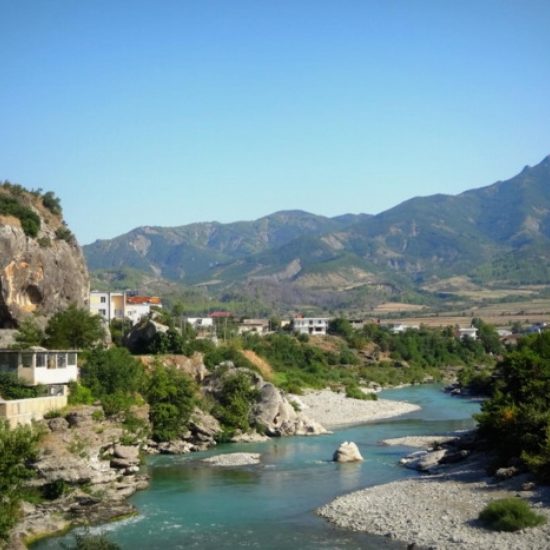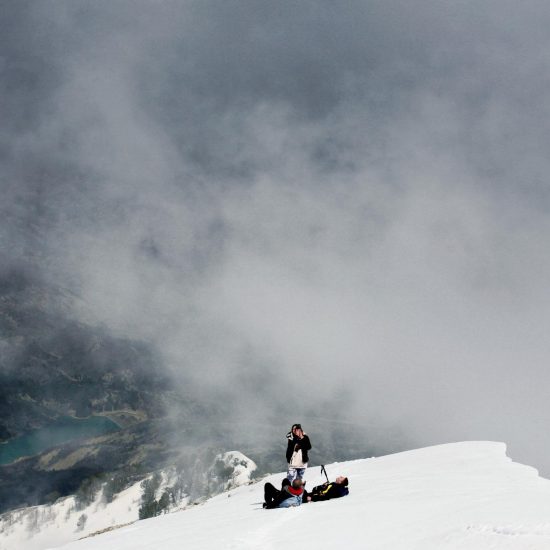Permet
In Permet, you will enjoy the tranquility and the abundance of flowers and greenery without end. You will find hospitality and touching kindness in the streets, houses, restaurants and hotels. A night in pleasant and comfortable hotels on the banks of the Vieuse will give you the impression of sleeping among the waves of the river itself. Permet, the city of flowers, roses, unforgettable songs and peace, was known as an administrative center as far back as the 15th century, and its several large markets were frequented by the inhabitants of the surrounding countries. Today we invite you to see the Gurin e Qytetit (City Stone), an amazing natural rock formation that is synonymous with the city. You should also visit the churches, especially the 18th century Leusa Church, famous for its icons and woodcuts, and the 12th century Shen Maria Church in Kosin. The restaurants of Permet and the surrounding area offer special cuisine and unforgettable service. Among the traditional famous dishes of the city, you can try injinari with olive oil, game meat (including wild boar) and delicious fish from Vyos. It is also worth tasting the famous wine (cabernet, merlot, etc.) and the traditional river, as well as delicious glyco, a sweet gelatin made from various fruits and nuts, especially walnuts. In summer you will find many coves in Permet along the river in the form of pools carved out of the banks of the river. The shores of Vyosa are often crowded with recreational anglers, and in the summer there is an annual canoeing competition, starting at the source of Vyosa, at the foot of the Pindi Mountains, and ending with a ceremony in the city of Permet. There are two other annual rituals: the International Multicultural Festival in June and the Dita e Verërave (Wine Day) in May. In the same month, the city hosts a national festival dedicated to famous personalities, born in the neighboring village of Frasher. Although this small town, Permet is the birthplace of many famous politicians, scientists, writers, musicians and artists of Albania. While here, you should not miss the opportunity to visit Fracher, which is 30 km from the city. This is the birthplace of the Frasheri brothers and many other famous personalities who laid the foundation of the Albanian nation. Traveling to the village, you will pass through Bradhy y Hotoves National Park, from where you can see incredible views of firs, pines and many freshwater springs. When you leave Permet behind, the road goes towards the town of Leskovik and the Greek border, only 30 km from the town. The city is famous for its thermal waters in Vronomero and hot springs in Postenan. But don’t say goodbye to Permet without visiting the thermal waters of Benj and the Lengarinka valley just 3 km from the city. There are six open natural sources of warm healing water even in winter. These waters flow from the beautiful canyons of two bridges: Ura e Kaykut and Ura e Dashit. There are six open natural sources of warm healing water even in winter. These waters flow from the beautiful canyons of two bridges: Ura e Kaykut and Ura e Dashit. There are six open natural sources of warm healing water even in winter. These waters flow from the beautiful canyons of two bridges: Ura e Kaykut and Ura e Dashit. There are six open natural sources of warm healing water even in winter. These waters flow from the beautiful canyons of two bridges: Ura e Kaykut and Ura e Dashit. There are six open natural sources of warm healing water even in winter. These waters flow from the beautiful canyons of two bridges: Ura e Kaykut and Ura e Dashit.
Berati
This 2407 year old city, an ancient Albanian architectural award and protected by UNESCO, is located 120 km from Tirana. The city forms a magnificent combination of eastern and western cultures, costumes, traditions and outlook. Berat is a treasure trove of Albanian history and culture, as well as a testament to the traditions of the country’s religious harmony. The life of the city began in the 6th-5th centuries BC as a settlement of the Illyrians. Later, in the 3rd century BC, it was turned into a castle town known as Antipatrea. Subsequently, the castle expanded, especially during the feudal rule of the Muzakai family. Churches with valuable frescoes and icons were built inside the castle, as well as a school of calligraphy. Uniquely today, residents still live within the castle walls. The three main districts of the old city are Mangalemy, Goritsa and Kala, where the castle itself is located. In Mangalem, under lock and key, you can see the famous view of the facades of houses with windows that seem to be standing on top of each other. In general, a traditional house has two floors, where the second one is prominent and has many curved windows and wood carvings. With its houses built along a steep hill, the view of Mangalem is the reason why Berat is also called the city of floating windows. Across the Osum River is the Goritsa district, whose houses overlook the houses of Mangalema. The arched bridge of Gorica, built in 1780, is an excellent architectural monument built to connect Gorica with Mangelemi. The ensemble of Byzantine churches in Berat Castle is extraordinary. At the foot of the castle is the Byzantine Shen Mekhill Church, while the 13th century Shen Maria e Blachernes Church, the Shen Triadha (Holy Trinity) Church and the post-Byzantine monumental Shen Maria Cathedral are located in the castle. The Shen Mayor’s Cathedral houses a museum of works by famous icon painters of the 16th century, Onufri and his son Nikolla. The exhibition features over 100 icons, as well as works by other artists such as Joan Chetiri, Onufer Kiprioti and many anonymous artists. You can also visit Shen Spiridoni Monastery in Gorica. In 1417, the Ottomans occupied Berat, and this conquest left its mark on the construction of monuments of the Islamic faith, such as Xhamia e Kuqe (Red Mosque) inside the castle, Xhamia e Plumbit (1555), Xhamia Mbret (16th century). ), and Xhamia e Beqarëve (1872). Other places worth visiting are the Ethnographic Museum, housed inside an 18th century chardak building, and the Art Gallery of Edward Lear, a famous English artist who painted much of Berat and Albania. In addition, Berat is known for its traditional dishes.
Mount Tomorr
The city of Berat is a good starting point for exploring Mount Tomorr (also called the Albanian Olympus or the Throne of the Gods), located 30-40 km from the city. Mount Tomorr is famous for its mystical appearance; it looks like a giant lion standing outside the city. It is one of the highest mountains in Albania, reaching 2416 m. The western slope is the most pleasant and covered with mixed vegetation. The forest mainly consists of beech, pine, maple, ash, fir. Bears, wolves, foxes, weasels and rabbits make up the park’s animal population. Mount Tomorr is ideal for mountain climbing, hiking and similar activities, and the area around the mountain is an ideal place for camping. Another interesting point on the mountain is Tirbja e Kulmakut and the tomb of Abaza Aliu, the saint of the Bektashi believers, is located at 1,200 m above sea level. In August, pilgrims visit his grave and offer many burnt offerings. This is the largest pilgrimage of Albanian and international Bektashi.
Osumi Canyons
Pirrogosh cave is located near the village of Radesh, halfway to the Osumi valley, in the Chorovoda stream. Pirrogos is the largest and longest cave in Albania, almost 1500 m long with an entrance 5 m wide. The most interesting part of the cave is a gigantic corridor filled with many different karst formations. The cave ends with a deep well full of colonies of bats.







